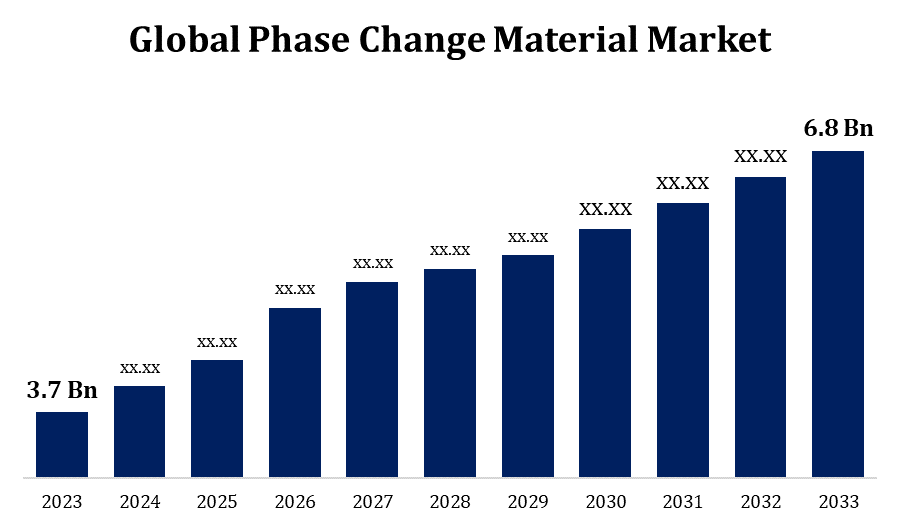Global Phase Change Material Market To Worth USD 6.8 Billion By 2033 | CAGR of 6.27%
Category: Chemicals & MaterialsGlobal Phase Change Material Market Size To Worth USD 6.8 Billion By 2033
According to a research report published by Spherical Insights & Consulting, the Global Phase Change Material Market Size to Grow from USD 3.7 Billion in 2023 to USD 6.8 Billion by 2033, at a Compound Annual Growth Rate (CAGR) of 6.27% during the forecast period.

Get more details on this report -
Browse key industry insights spread across 200 pages with 110 Market data tables and figures & charts from the report on the "Global Phase Change Material Market Size By Type (Organic, Inorganic, Eutectic), By Application (Building and Construction, Packaging, Textiles, Electronics, Transportation), By Region, And Segment Forecasts, By Geographic Scope And Forecast to 2033. " Get Detailed Report Description Here: https://www.sphericalinsights.com/reports/phase-change-material-market
Building envelopes, walls and roofs use Phase Change Material to alter interior temperatures and reduce heating and cooling energy use. In clothes, bedding, and sports, materials impregnated with Phase Change Material are used to improve comfort by actively managing body temperature. Incorporating Phase Change Material into building materials increases thermal mass, which helps to stabilise indoor temperatures and lessens the requirement for HVAC systems. The growing global emphasis on energy efficiency and stringent building requirements is driving demand for Phase Change Material in construction. Microencapsulation technology breakthroughs improve Phase Change Material stability and performance in a variety of applications.
Phase Change Material Market Value Chain Analysis
Organic Phase Change Materials require the manufacture of specific chemical molecules, such as fatty acids or esters. Inorganic Phase Change Materials may necessitate the extraction or synthesis of salts or metals. Raw materials are processed and compounded to create Phase Change Material products. Encapsulation, for example, is a procedure in which Phase Change Material is microencapsulated for better stability and performance. Stringent quality control measures are used to attain the correct thermal characteristics and performance of the Phase Change Material. Phase Change Material goods are distributed through a variety of channels, including manufacturers, distributors, and specialised suppliers. Part of the sales effort includes reaching out to firms and areas where Phase Change Material may provide energy-efficient solutions, such as building construction, textiles, electronics, and cold chain logistics. Building materials use Phase Change Material to control thermal energy and increase energy efficiency.
Phase Change Material Market Opportunity Analysis
The growing construction activity throughout the world opens up the possibility of incorporating Phase Change Materials into building materials to improve energy efficiency and temperature regulation. The rising demand for green construction approaches and certifications creates an opportunity for Phase Change Material as a green building solution. The ability of Phase Change Material to store and release thermal energy correlates with the growth of renewable energy sources, particularly solar. Phase Change Material can enhance solar energy systems by storing excess energy for later use. With the expansion of the cold chain logistics industry, Phase Change Material has the potential to play a vital role in maintaining proper temperatures during the storage and transportation of temperature-sensitive commodities.
In order to increase thermal mass, reduce temperature swings, and improve energy efficiency, Phase Change Materials are utilised in construction. This is particularly beneficial in climate-sensitive places. Phase Change Materials contribute to green building certifications such as LEED (Leadership in Energy and Environmental Design) because they adhere to requirements emphasising energy efficiency and sustainability. Because Phase Change Material can store and release thermal energy, it minimises the need for HVAC (Heating, Ventilation, and Air Conditioning) systems, resulting in energy and cost savings. Phase Change Material integration increases indoor thermal comfort by stabilising temperatures, lowering overheating, and lowering the demand for external heating or cooling.
The initial costs of incorporating Phase Change Material into architectural materials or products may be greater than normal options. Adoption can be hampered by this, especially in organisations with limited resources. Phase Change Material must be compatible with a wide range of construction materials and systems. It is difficult to achieve seamless integration while maintaining structural integrity. Architects, builders, and other industry stakeholders are unfamiliar with and do not understand Phase Change Material technology. Education activities are required to bridge this knowledge gap and promote wider use. The lack of standardised testing procedures and certifications for Phase Change Material equipment might lead to performance misunderstanding and make setting unambiguous standards difficult.
Insights by Type
The organic segment accounted for the largest market share over the forecast period 2023 to 2033. Organic Phase Change Materials, such as fatty acids and esters, are carbon-based compounds. The use of organic materials promotes environmentally friendly alternatives and aligns with sustainability goals. Organic Phase Change Materials provide a wide temperature range of transition, allowing you to select materials that fulfil specific temperature requirements in a number of applications. This versatility boosts their usefulness in a wide range of sectors. Organic Phase Change Materials (OPCMs) are utilised in building materials to improve thermal mass and regulate indoor temperatures. This application contributes to energy-efficient and ecologically friendly construction approaches. Organic Phase Change Materials (OPCMs) are being researched for thermal management in electronics, with the goal of assisting in the effective cooling of electronic equipment and decreasing overheating.
Insights by Application
The building and construction segment accounted for the largest market share over the forecast period 2023 to 2033. Incorporating Phase Change Material into building materials increases thermal mass, which aids in temperature regulation and reduces the need for external heating or cooling. Applications of Phase Change Materials help to obtain Leadership in Energy and Environmental Design (LEED) certification and other green building criteria that highlight energy efficiency and sustainability. Integration of Phase Change Materials helps to optimise HVAC systems by minimising the frequency and intensity of temperature adjustments, resulting in energy savings. To improve energy efficiency in applications such as insulation and roofing, Phase Change Material is used in residential building. Commercial structures, such as offices and retail spaces, use Phase Change Material to help accomplish sustainability goals.
Insights by Region

Get more details on this report -
North America is anticipated to dominate the Phase Change Material Market from 2023 to 2033. The emphasis on energy efficiency in building design and construction in North America creates a conducive environment for Phase Change Material adoption. To increase thermal mass and regulate indoor temperatures, Phase Change Material is utilised in construction materials. Leadership in Energy and Environmental Design (LEED), a globally acknowledged green building grading system, advocates the use of sustainable materials such as Phase Change Material in construction projects. Research institutes and innovation hubs in North America are actively working to enhance Phase Change Material technology, investigate new formulations, and widen its applications. Integration of Phase Change Materials enhances HVAC system performance by reducing the need for frequent temperature adjustments, resulting in energy savings in commercial and residential buildings.
Asia Pacific is witnessing the fastest market growth between 2023 to 2033. The Asia-Pacific area is quickly industrialising, which is boosting demand for energy-efficient and environmentally friendly manufacturing technologies. Phase Change Material is used in industrial applications to improve heat control. As a result of urbanisation and infrastructure development, the Asia-Pacific construction business is quickly increasing. Phase Change Material is utilised in building materials to improve energy efficiency and lessen the environmental impact of construction. The Asia-Pacific region is a manufacturing powerhouse. For thermal management, Phase Change Material is utilised in the automotive industry, which helps to increase vehicle energy efficiency. The region's agricultural resources are abundant, ensuring a steady supply of natural fibres for use in biocomposite materials with Phase Change Material applications.
Recent Market Developments
- In October 2022, Shanghai Polytechnic University researchers developed highly efficient phase change microcapsules for storing solar energy.
Major players in the market
- AI Technology Inc.
- Boyd Corporation
- Climator Sweden AB
- Cold Chain Technologies
- Croda International PLC
- Cryopak Industries Inc
- Dupont De Nemours
- Henkel Ag & Company KGaA
- Honeywell Electronic Materials
- Microtek Laboratories Inc.
- Phase Change Energy Solutions
- Pluss Advanced Technologies
- Puretemp LLC
- Rubitherm Technologies GmbH
- Sasol Limited
Market Segmentation
This study forecasts revenue at global, regional, and country levels from 2023 to 2033.
Phase Change Material Market, Type Analysis
- Organic
- Inorganic
- Eutectic
Phase Change Material Market, Application Analysis
- Building and Construction
- Packaging
- Textiles
- Electronics
- Transportation
Phase Change Material Market, Regional Analysis
- North America
- US
- Canada
- Mexico
- Europe
- Germany
- Uk
- France
- Italy
- Spain
- Russia
- Rest of Europe
- Asia Pacific
- China
- Japan
- India
- South Korea
- Australia
- South America
- Brazil
- Argentina
- Colombia
- Middle East & Africa
- UAE
- Saudi Arabia
- South Africa
About the Spherical Insights & Consulting
Spherical Insights & Consulting is a market research and consulting firm which provides actionable market research study, quantitative forecasting and trends analysis provides forward-looking insight especially designed for decision makers and aids ROI.
Which is catering to different industry such as financial sectors, industrial sectors, government organizations, universities, non-profits and corporations. The company's mission is to work with businesses to achieve business objectives and maintain strategic improvements.
CONTACT US:
For More Information on Your Target Market, Please Contact Us Below:
Phone: +1 303 800 4326 (the U.S.)
Phone: +91 90289 24100 (APAC)
Email: inquiry@sphericalinsights.com, sales@sphericalinsights.com
Contact Us: https://www.sphericalinsights.com/contact-us
Need help to buy this report?